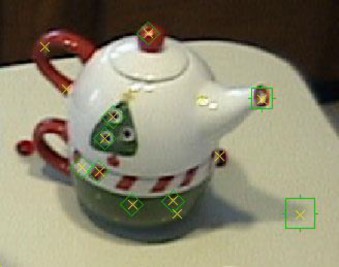< Previous | Contents | Manuals Home | Boris FX | Next >
Lights from Shadows
Consider the two supervised trackers in the image below from the BigBall example scene:

One tracks the spout of a teacup, the other tracks the spout’s shadow on the table. After solving the scene, we have the 3-D position of both. The procedure to locate the light in this situation is as follows.
Switch to the
Lighting Control Panel
![]() . Click the New Light button, then the New Ray button. In the camera view, click on the spout tracker, then on the tracker for the spout’s shadow.
. Click the New Light button, then the New Ray button. In the camera view, click on the spout tracker, then on the tracker for the spout’s shadow.
We could turn on the Far-away light checkbox, if the light was the sun, so that the direction of the light is the same everywhere in the scene.
Hint : if the sun is visible (typical for 360 VR shots), create a single ray with a far tracker as the Source tracker, to solve for the sun, configured as a Far- away light.
Instead, we’ll leave the checkbox off, and instead set the distance spinner to 100, moving the light away that distance from the target.
The light will now be positioned so that it would cast a shadow from the one tracker to the next; you can see it in the 3-D views. The lighting on any mesh objects in the scene changes to reflect this light position, and you see the shadows in the perspective view. You can repeat this process for the second light, since the spout casts two shadows. This scene is Teacup.sni.
If the scene contained two different teapot-type setups due to the same single light, you can place two rays on one light, and the 3-D position of the light will be triangulated, without any need for a distance.
SynthEyes handles another important case, where you have walls, fences, or other linear features casting shadows, but you can not say that a single point casts a shadow at another single point. Instead, you may know that a point casts a shadow somewhere on a line, or a line casts a shadow onto a point. This is tantamount to knowing that the light falls somewhere in a particular 3-D plane. With two such planes, you can identify the light’s direction; with four you may be able to locate it in 3-D.
To tell SynthEyes about a planar constraint, you must set up two different rays, one with the common tracker and one point on the wall/fence/etc., and the other ray containing the common tracker and the other point on the wall/fence/etc.
©2024 Boris FX, Inc. — UNOFFICIAL — Converted from original PDF.
